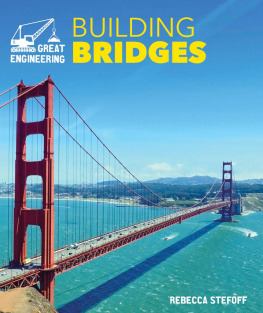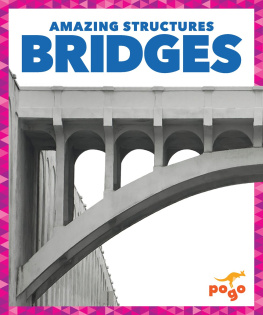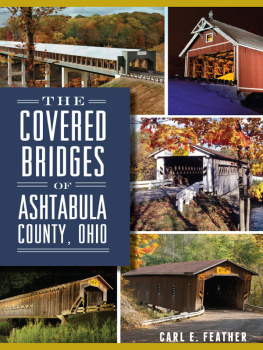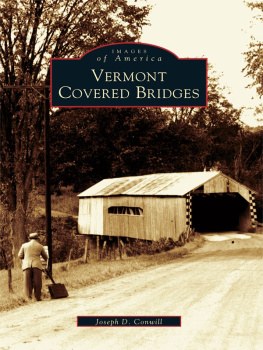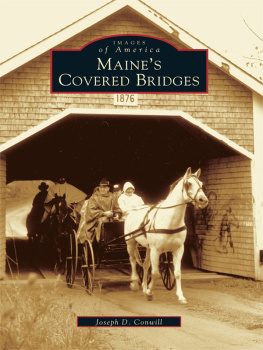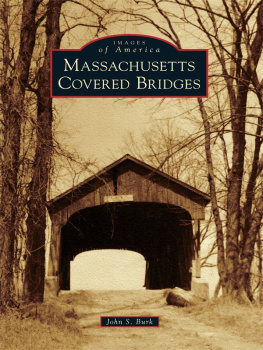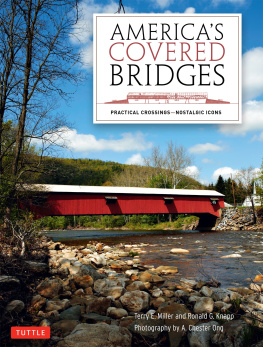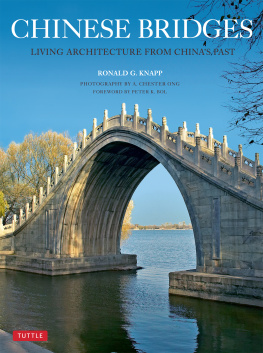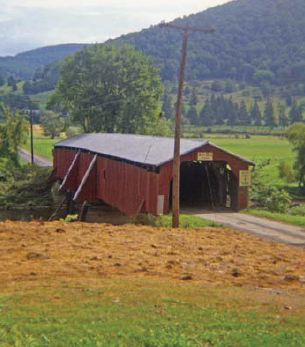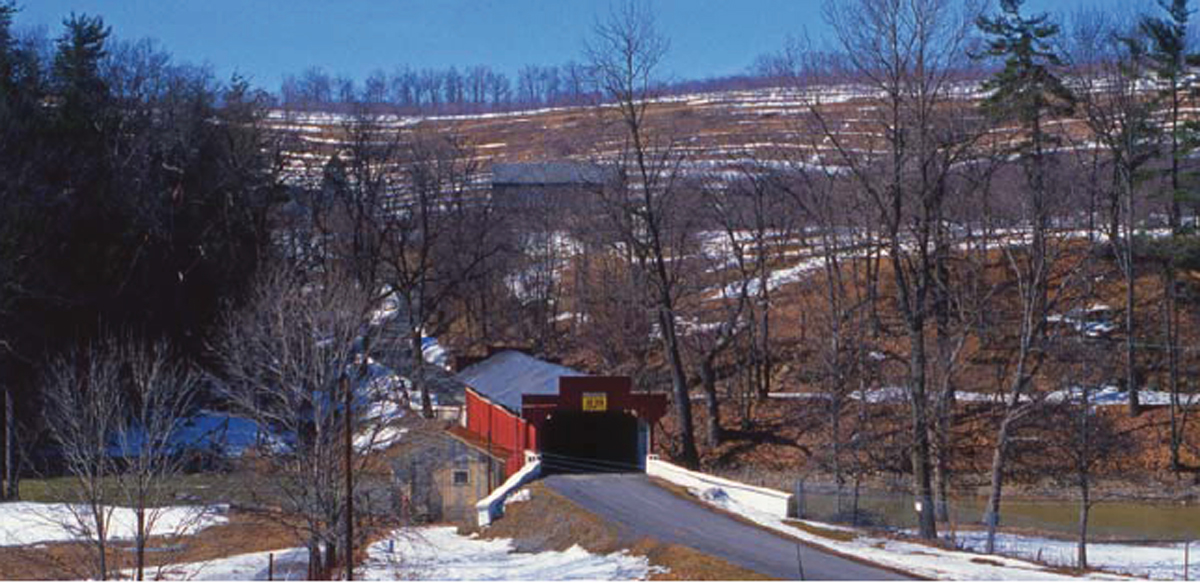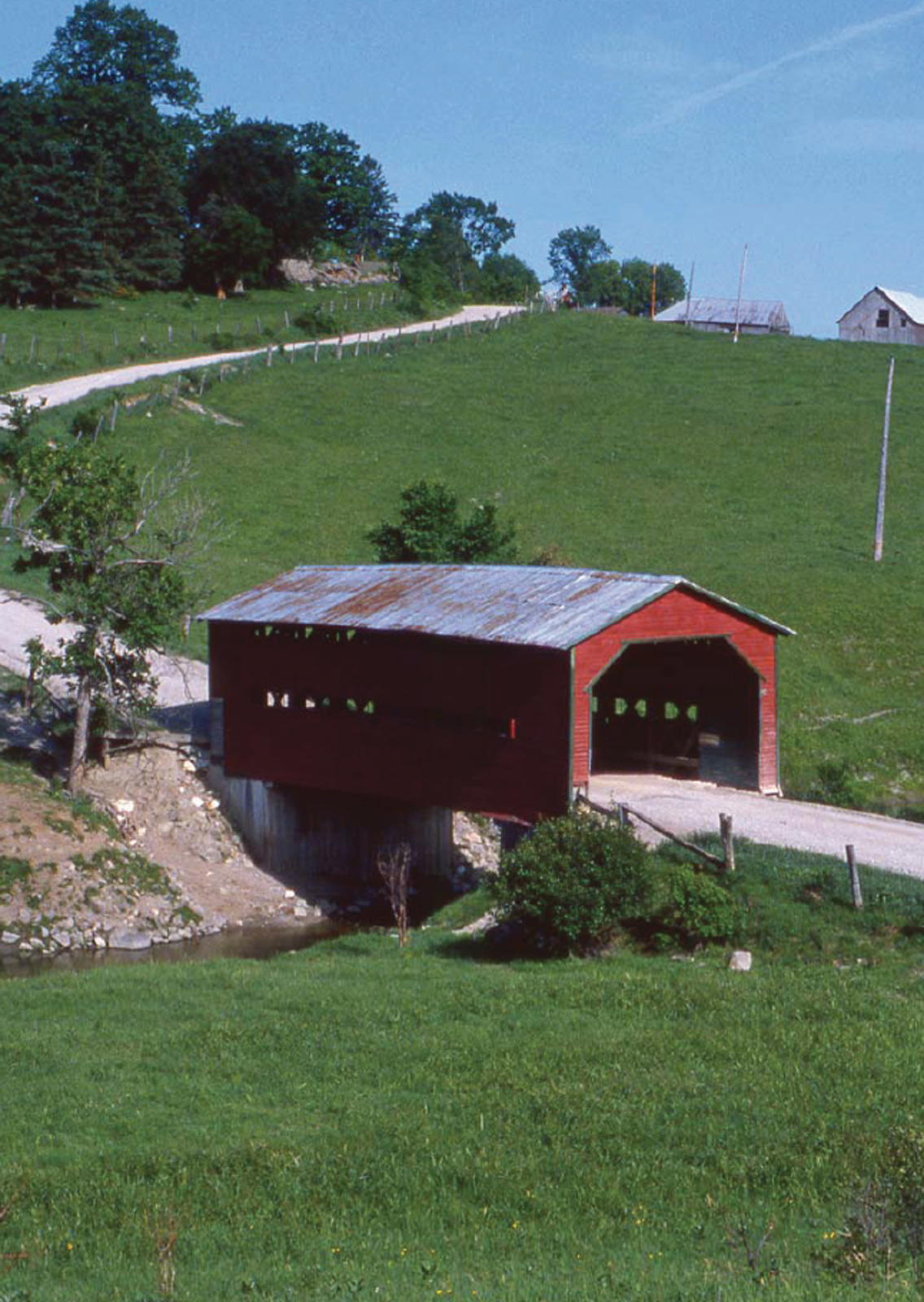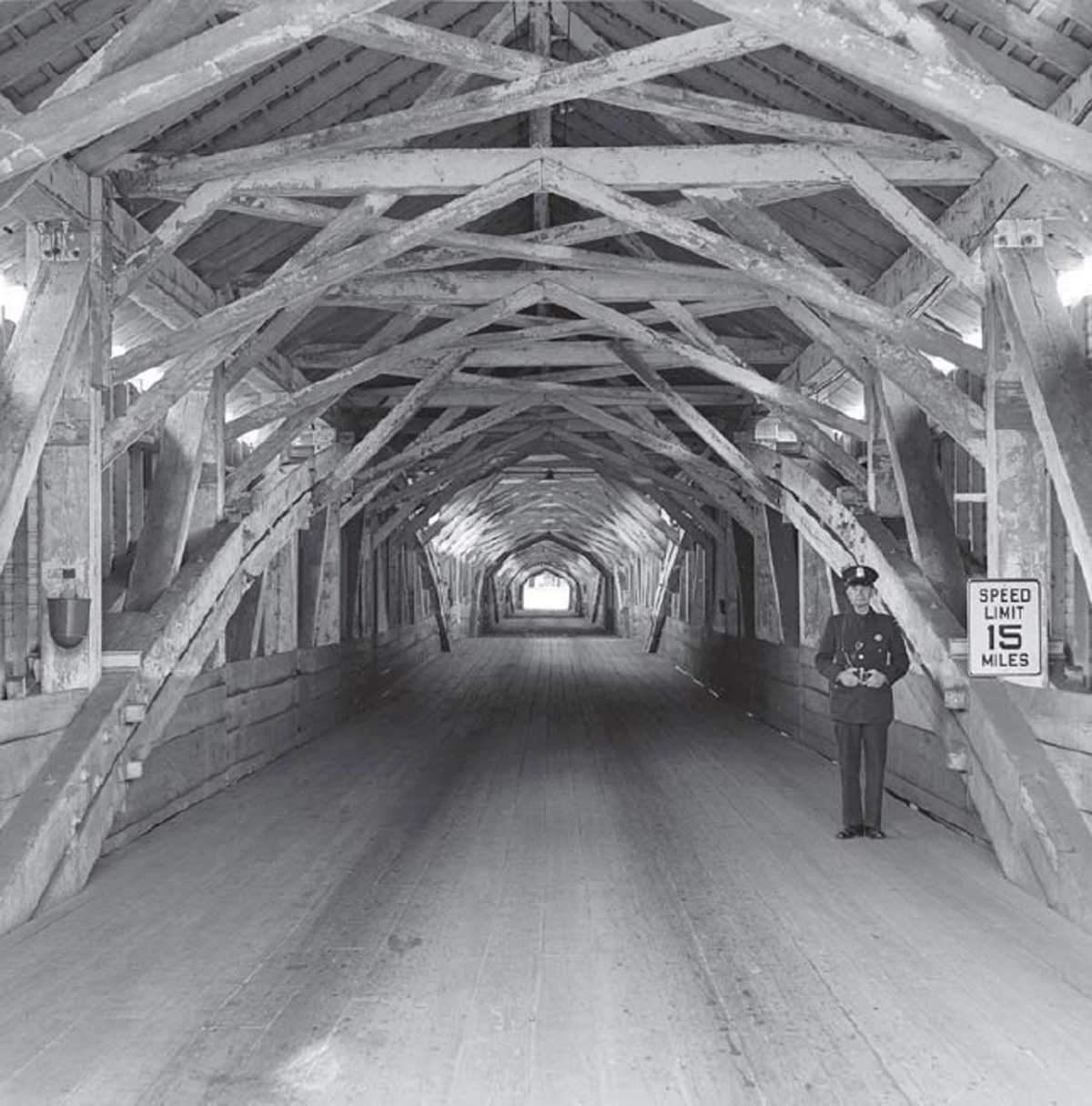COVERED BRIDGES
Joseph D. Conwill
Hamden Bridge in Delaware County, New York is shown in this 1972 photograph. Part of the old structure still stands, but it has been heavily reworked.
Geigers Bridge graces the Jordan Creek valley northwest of Allentown. It has the false-front portals sometimes found on covered bridges of southeastern Pennsylvania. The stone parapets along the approaches are typical of the region.
CONTENTS
This lovely covered bridge in the Gatineau Valley of Qubec is just a few miles north of Canadas capital city of Ottawa, Ontario.
INTRODUCTION
T HE OLD COVERED bridge is a powerful symbol of American rural life. The timber tunnel, fragrant and mysterious, carries the traveler safely over a gurgling stream, along the road from bright green fields to cool shady woods. This dreamworld image does not always match reality, but it comes close often enough to make covered bridges among the most popular symbols of Americana. They are also very accessible symbols, being found in most parts of the United States except for the High Plains and the Rockies, and in much of eastern Canada as well.
The redevelopment of the rural economy as a suburban one, based on travel to jobs elsewhere, has made covered bridge preservation more difficult. Most covered bridges as originally built could have carried heavy loads such as school buses, fire engines, or oil trucks on an occasional basis, but the bridges suffered from decades of neglect which weakened many of them early in the twentieth century. Until the 1960s the common expectation was that the covered bridges would eventually all be replaced with concrete, and many did not receive even routine maintenance. Since then, their popularity has inspired various efforts to keep them in service, although the vastly increased traffic volume on rural roads brings special challenges in dealing with one-lane bridges. Bypassing them is a possibility, but all structures need repairs now and then, and it is often hard to find funding for repairs unless the bridge is still carrying traffic.
The historical period of covered bridge construction lasted from about 1805 to 1955. In the northeastern United States no new covered bridges were built after World War I. Construction in the Midwest lasted into the 1920s, and in parts of the South into the 1930s. In the Pacific Northwest, and also in parts of eastern Canada, where large supplies of high quality timber were still locally available, covered bridge construction lasted into the 1950s. The later covered bridges were built for automobile traffic from the very start. The United States still has 674 covered bridges from this historical time period, although over a third of them have been significantly modernized. Canada has 144, and more of them are original because on average they are more recent.
The former ColumbiaPortland Bridge over the Delaware River between New Jersey and Pennsylvania shows the mystery of the long, timbered tunnel. It was an excellent example of the Burr truss type of construction.
The popularity of the covered bridge concept inspired several thousand imitations from the mid-1950s onwards. Most of these were mere decorative shells erected over concrete bridges, or structures built of small dimension lumber in backyards. They obviously had no relation to the historical prototypes other than as testaments to their popularity, but guidebooks and press accounts often cited them as if they were real. This explains the wild misstatements still frequently encountered that there are over eight hundred, or fifteen hundred, or even three thousand covered bridges in the United States, for by now the modern imitations greatly outnumber the originals, just as recent suburban houses of colonial style outnumber real colonial-era dwellings.
From the late 1960s onwards, a greater awareness of historical building techniques led to the construction of a few new covered bridges that closely resembled the old ones. At first they were all-new road crossings, or else replacements for old covered bridges that had been accidentally lost to floods or fire. Their widespread acceptance in the historical world, however, allowed an unfortunate new phase of history starting in the 1980s: a number of old covered bridges have now been intentionally torn down and replaced with replicas. Most of these bridges could have been strengthened by the addition of laminated arches, a common reinforcement technique in the late-nineteenth century, but now they are completely lost. Even very good replicas lack the real physical connection with the past of structures washed by the passing waves of humanity, in Ruskins famous phrase. Covered bridges are our only historical monuments for which modern reproductions are widely offered as equivalent to the originals, and their future is far from secure, despite their popularity.
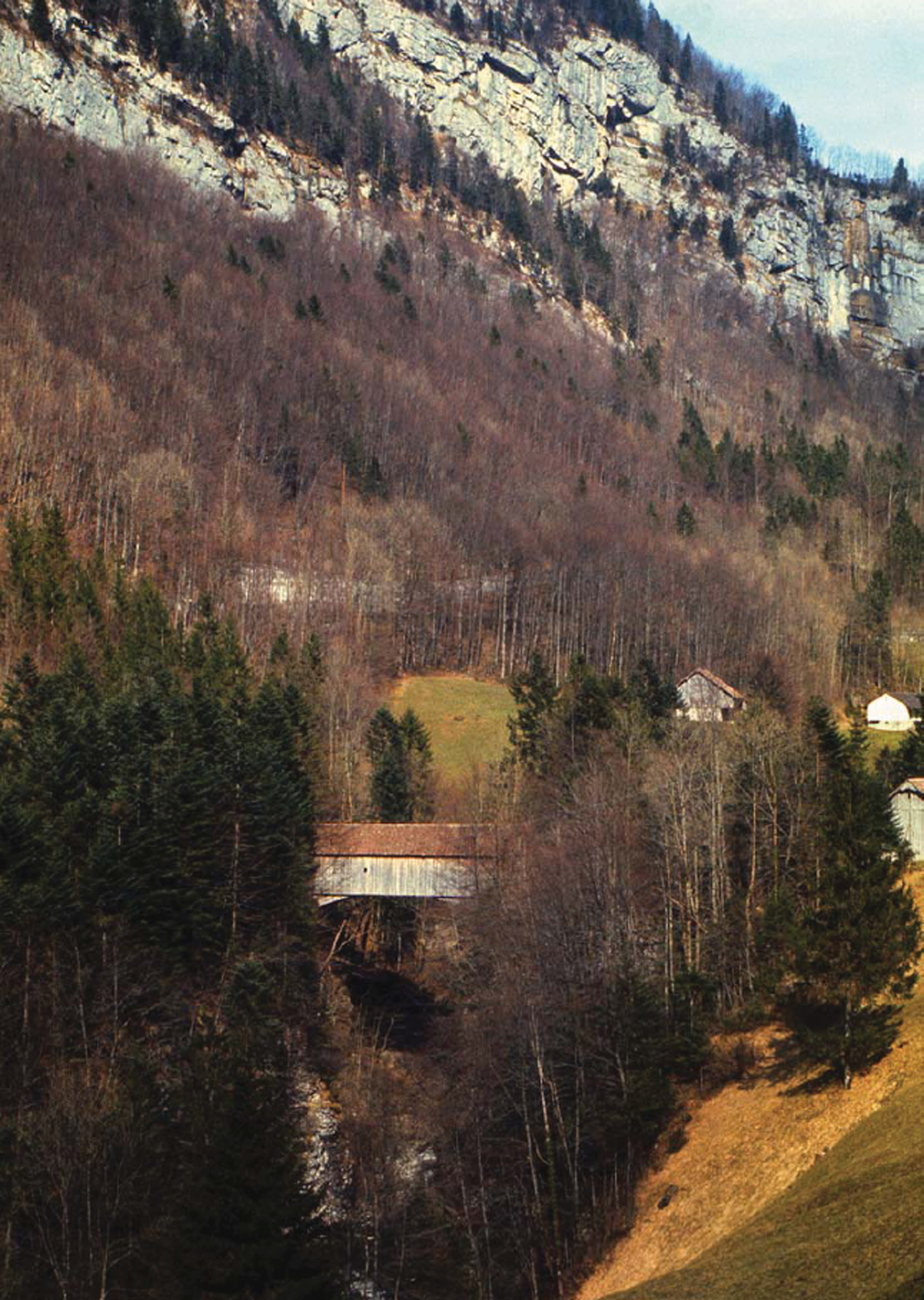
Suvorov Bridge graces the alpine landscape of Canton Schwyz in Switzerland. American designers knew of a few Swiss bridges, but they did not copy Swiss styles of building.
A covered bridge is a truss bridge, a complicated framework built up of relatively short pieces of timber, which can carry loads across spans much longer than the individual timbers themselves. Americans used wood because it was inexpensive and widely available, but by the 1790s it was obvious that unprotected wooden structures had short life spans, often just ten or fifteen years. Wood preservatives did not yet exist; paint was sometimes used, but water could still infiltrate cracks and joints. Builders in central Europe also used timber, and from late-medieval times onwards they had roofed their bridges to prevent decay. A few Swiss examples were widely publicized in America from the late 1700s onwards by travelers and technical writers. China also built large numbers of covered wooden bridges, but these were completely unknown in the West until very recently.
By 1800 Americans too were discussing covered bridges. The idea was in the air, but it seems not to have been imported directly from Europe despite some knowledge of the precedent. American bridge builders did not adopt the heavy-timbered arch-brace designs that were popular in Switzerland, nor was there any cross-Atlantic interchange of talent, as happened for example in the history of military fortifications.
Timothy Palmers Permanent Bridge over the Schuylkill River at Philadelphia, completed in 1805, was the first known American covered bridge. Palmer (17511821) was a long-established builder of open wooden bridges over major rivers such as the Merrimack and the Piscataqua, and the Permanent Bridge came near the end of his career. He covered it at the suggestion of a major investor in the toll bridge company that owned it, and the idea immediately proved its worth. Philadelphias Permanent Bridge lasted forty-five years, and was torn down in 1850 only because a new bridge for a railroad was needed on the site. Within just a few years of its construction, covered bridges became the standard for important river crossings.


